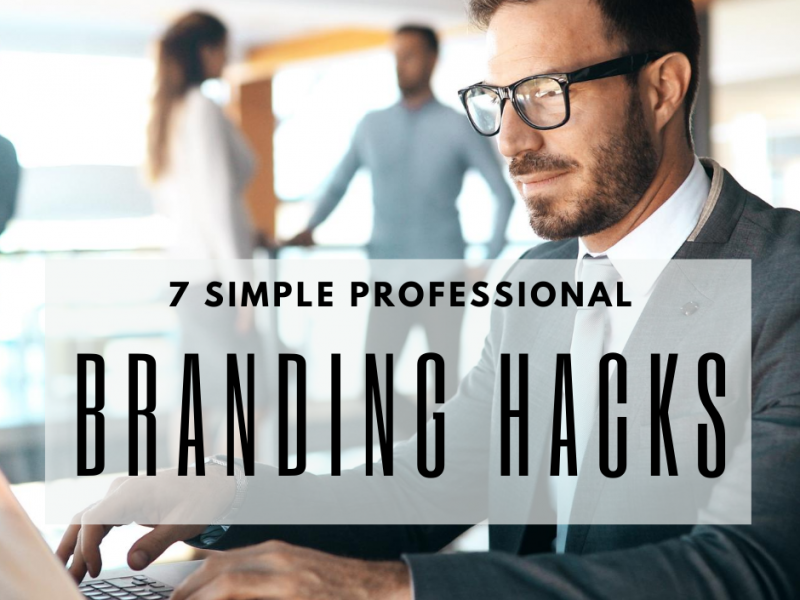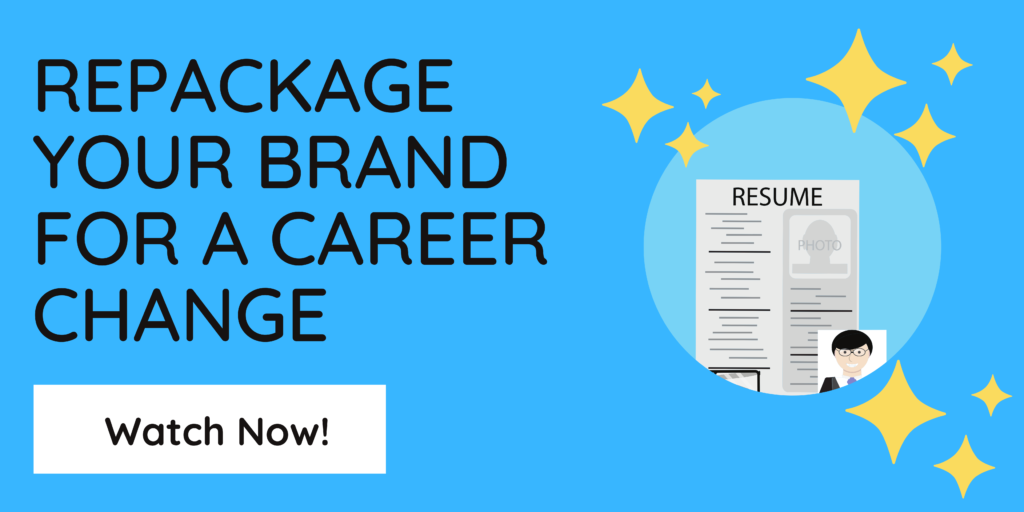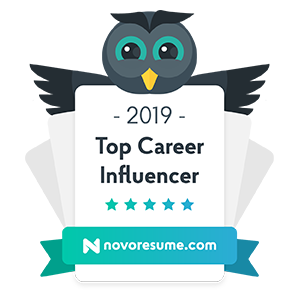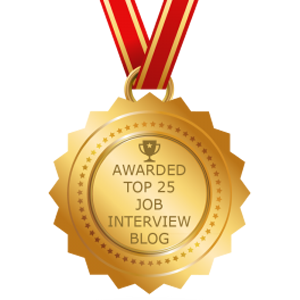Projecting the right brand for your target industry and role is essential for being found by employers and hired. However it’s an area of the job search where people tend to struggle the most. In addition to writing your own branding statements, there are other simple strategies that will ensure your brand is working for you. In this post we will define all of the key components to your professional brand. We will then share some simple professional branding hacks that can really give your brand AND your job search a boost.
Professional branding can make or break your job search
How you portray yourself in the job search has everything to do with whether or not you will be hired. This is the power of professional branding. Without a solid brand, people – your network, recruiters, hiring managers – won’t be convinced you can do the job. And if you don’t appear to be able to do the job, well, you get the point. Therefore it is incredibly important to focus part of your job search efforts on professional branding. Your professional branding will form the first impression for hiring managers. What first impression do you want to make with the hiring manager? Simple – you must speak to your future value as an employee.
Professional branding must achieve fit and differentiation at the same time
Professional branding must achieve fit – in that you must look the part for the job. You must have the right experience (or close experience). You must appear to have potential to be successful in your target role. In some sense you must also look the part of your industry. Work in a conservative industry like finance? You might not want to showcase your tattoos. In this sense, fit is important. However, you also want to strike a balance with differentiation. What sets you apart from the other job candidates around you? Your professional brand should communicate who you are, what you do, and how you do it. Your brand should be communicated instantly when interacting with other professionals.
“I used my new resume to apply for the job that I had mentioned to you, this week. They called me in for the interview the day after they received my resume!”
– Luey, Resume Makeover Client
Professional branding consists of several important parts
When people think “branding” they tend to think of long hours of rigorous writing. Yes, writing is a big part of how you improve your brand. But it isn’t the only part of branding on which you should focus. Branding is also about “where you are” and “how you look” from an experiential standpoint. What is the overall experience someone has, when encountering your online profile? Resume? Networking conversation? Job interview conversation? You will want to focus on improving all areas of your brand – not just your resume – if you are to really exude a persona synonymous with your target roles.
How to improve your professional brand without spending hours writing about you
Since branding has several parts, you want to focus on the writing as well as the other less tangible parts. The good news is: the less tangible parts are super simple to implement. Therefore you should add these hacks to your “to do” list asap!
1. Become a regular at industry events
LinkedIn is a must when it comes to establishing your professional profile. With over 600 million members, it is amongst the most important database for hiring managers, recruiters, business-minded folks and basically anyone looking to find that right person for their needs. So being on LinkedIn is not optional when it comes to your career. However it’s not the only place you should consider showcasing your online profile. Think about all the other online places professionals in your space may congregate. Search google for associations, members-only industry organizations, conferences, industry networking groups, and more! Skim event listings at your local library. Larger libraries often host industry-specific speakers and events. Set an alert to check for events in your space monthly. Once you know where your tribe is meeting, start to make attendance at this events a priority!
Download Noelle’s Online Networking Guide & Checklist Now!
2. Tweak your SEO strategy to appear in more searches
Having an online presence is also important in the branding game for search engine optimization or SEO. SEO determines which results appear first in an online search and which results end up on the 23rd page – the page you never visit. Your professional brand SEO is determined by a number of factors. It’s important to be on top of these factors as part of your online professional management. Doing a keyword audit of your online profiles, is one way to be highly searchable. Use job descriptions to identify the strongest keywords and then add them to your profiles. On LinkedIn you can also improve your SEO by being connected to a lot of people. Yes, that includes strangers! LinkedIn returns search results based on the relevancy to the searcher. Because you want to increase your chances of being found in relevant searches, you will need to connect with a lot of people. Better yet, dedicate a few minutes a week to connecting with people in the space you are targeting. This way you will be more relevant to potential hiring managers and high-value networking leads.
3. Get your network to do the branding for you
People are always curious to know if LinkedIn references are effective in the hiring game. This is an interesting question. From a recruiting perspective I would answer “no.” The reason for this, is because people are likely to to post their best references making the validity slightly biased. Furthermore, as a recruiter, I would still conduct a reference check even if the candidate made it through the interview process. However, references do contribute to profile branding in a positive way. They also present the benefit of allowing your network to sell your brand for you! Therefore it’s worth your while to engage your past managers, clients or other high-profile industry players (think CEO or company leadership) – for a recommendation. Be strategic in selecting your references so they speak to your desired brand. Better yet, offer suggestions if asked – so your contact will know on which traits you’d like the recommendation to be focused!
4. Don’t overlook your strongest branding asset
With all this talk of profile updates, keywords and SEO, it might be easy to overlook one of your best brand assets: your LinkedIn photo. That’s right, branding is not for the photo-shy. In this era of online profiles, the photo is actually a key branding tool. It gives the viewer an immediate sense of transparency and a glimpse into who you are and what you’re about. It also has the potential to draw the searchers in OR deter them. Think about it: do you really want to invest your online search time looking into a profile without a photo? It makes us doubt the authenticity of the profile. Select your photo carefully and aim for a clean headshot that portrays approachability, personality & authenticity to you and/or your target industry. If you are at a loss for ideas, check out what the people you admire are using and aim for something similar.
5. Don’t overlook your 2nd strongest branding asset
The LinkedIn headline is just as important as the photo. It is the first thing your contacts will see when they land on your photo. Being able to concisely summarize your professional brand in 120 characters does require some writing savvy. However, 120 characters is nothing compared to a robust professional bio! Browse other profiles and jot down words/phrases that jump out at you. Create a master list of all the words you’d like to describe exactly who you are and what you do. Then narrow down your list by trying different word/phrase combos. You are bound to hit the jackpot with a little brainstorming and rearranging.
6. Join every online group within your target space
Similar to event attendance, online groups present the perfect venue for showcasing your professional presence. LinkedIn groups is an obvious choice for finding tons of relevant professional groups. First join every group in your target industry. Then search for groups of people with your target role (ie. CEOs, Project Managers, Accountants, Executives, etc.) Once you’ve joined groups in your professional sphere, search for groups of people who share similar interests. LinkedIn boasts a wide variety of groups. Do some digging and join anything relevant. You will also want to join these recruiter groups while you’re there!
Facebook groups are another way to meet like-minded people. Many job seekers have found valuable job leads in these groups simply because of its casual nature. For example if you join a special interest group around cars, you will start to make casual connections with other car enthusiasts in the group. You never know where these new-found online friends work, or who they know who could help your career. Therefore, it’s not totally invaluable to become a social butterfly on social media. It’s important however, that you just be aware of your posting – keep it professional and neutral so as to not turn-off any contacts.
Of course after you join groups, you will want to spend some of your job search hours each week trolling the group. Identify potential networking contacts, respond to posts, share advice – there are tons of ways to leverage groups for your benefit. The more active you become in the group the more you will be associated as someone who is passionate about your profession. You never know how this will resonate with someone in the group looking to make their next hire!
7. Share industry-relevant content on your feed
One super simple way to look the part is by sharing industry-related content. Sharing content on your LinkedIn or other social feed carries many benefits. It is the equivalent of talking in the social media world. And you want to be constantly talking about a profession where you have passion. It creates an impression with your network and they will start to associate you with the content you post. Posting doesn’t have to be time consuming. It can be as simple as liking or re-sharing a post you’ve found in your own feed! Make a point to share several posts a week. The more you talk about your target industry, the more you will garner credibility as an enthusiast or even expert in that space.



 How to Create and Communicate Your Professional Brand
How to Create and Communicate Your Professional Brand


